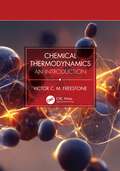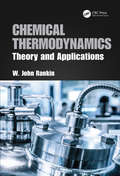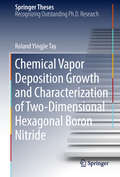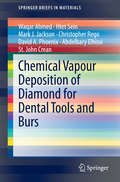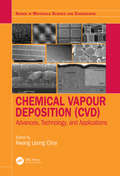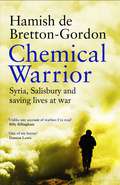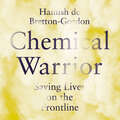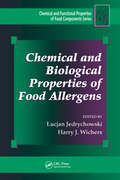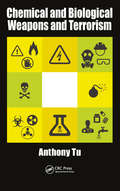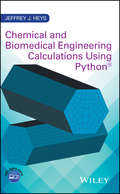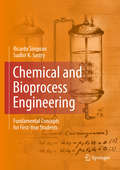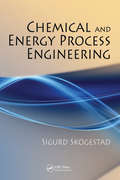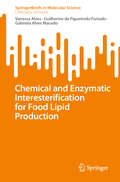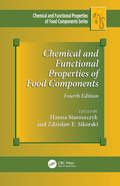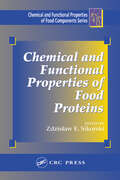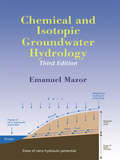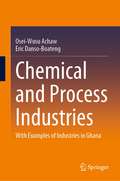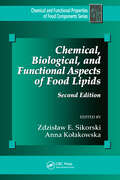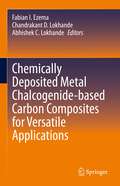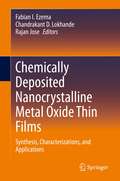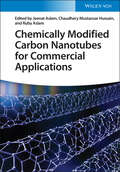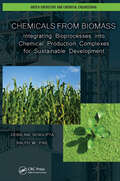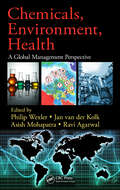- Table View
- List View
Chemical Thermodynamics: An Introduction
by Victor CM FreestoneThermodynamics can never be made easy, but with the right approach and a consistent use of scientific terms it can be made less opaque, and it can give a person, who is prepared to try, an insight into how science explains why things happen the way they do. The approach adopted in this book will give readers a better understanding of how science works together with its limitations. Unfortunately, thermodynamics, or at least some parts of it, is a subject which (apart from quantum mechanics) probably causes most confusion and bewilderment amongst scientists. The majority of students do not understand or “get” thermodynamics, and it is considered a “hard” or difficult subject. There are multiple reasons for this. There is of course mathematics, and many thermodynamic texts appear to be lists upon lists of differential equations. Another reason is that thermodynamics is, as often as not, poorly taught by teachers/lecturers who themselves do not understand, or appreciate, or have any interest in the subject (often all three). This results not only in a lack of scientific rigorousness in the teaching of the subject with the resulting confusion, and sometimes teachers, lecturers and authors just get it plain wrong (this occurs surprisingly often). However, it need not be like this and although mathematics (including calculus) is required, it can be kept to a relatively elementary level in order to obtain an understanding of this most important of subjects. No one can pretend that the subject is easy, but it can be made more accessible by a rigorous definition of terms and concepts and ensuring that a consistency of use of these definitions is maintained.Highlighting the benefits of thermodynamics in practical science, the text gives an intuitive grasp of the major concepts of thermodynamics such as energy and entropy. Provides a new pedagogic approach to understanding and teaching chemical thermodynamics. Starting with a set of basic simple assumptions about what constitutes topics such as an ideal gas, theories are developed in a clear, concise and accessible manner that will either answer or at the very least give an insight into a surprising range of scientific phenomena including energy, heat, temperature, properties of gases, time and quantum theory. Assumes that the reader has essentially no knowledge of the subject. Mathematics (including calculus) is kept to a relatively elementary level in order to obtain an understanding of this most important of subjects. Provides the reader with a better understanding of how science works together with its limitations.
Chemical Thermodynamics: Theory and Applications
by W.J. RankinThis book develops the theory of chemical thermodynamics from first principles, demonstrates its relevance across scientific and engineering disciplines, and shows how thermodynamics can be used as a practical tool for understanding natural phenomena and developing and improving technologies and products. Concepts such as internal energy, enthalpy, entropy, and Gibbs energy are explained using ideas and experiences familiar to students, and realistic examples are given so the usefulness and pervasiveness of thermodynamics becomes apparent. The worked examples illustrate key ideas and demonstrate important types of calculations, and the problems at the end of chapters are designed to reinforce important concepts and show the broad range of applications. Most can be solved using digitized data from open access databases and a spreadsheet. Answers are provided for the numerical problems. A particular theme of the book is the calculation of the equilibrium composition of systems, both reactive and non-reactive, and this includes the principles of Gibbs energy minimization. The overall approach leads to the intelligent use of thermodynamic software packages but, while these are discussed and their use demonstrated, they are not the focus of the book, the aim being to provide the necessary foundations. Another unique aspect is the inclusion of three applications chapters: heat and energy aspects of processing; the thermodynamics of metal production and recycling; and applications of electrochemistry. This book is aimed primarily at students of chemistry, chemical engineering, applied science, materials science, and metallurgy, though it will be also useful for students undertaking courses in geology and environmental science. A solutions manual is available for instructors.
Chemical Vapor Deposition Growth and Characterization of Two-Dimensional Hexagonal Boron Nitride (Springer Theses)
by Roland Yingjie TayThis thesis focuses on the growth of a new type of two-dimensional (2D) material known as hexagonal boron nitride (h-BN) using chemical vapor deposition (CVD). It also presents several significant breakthroughs in the authors’ understanding of the growth mechanism and development of new growth techniques, which are now well known in the field. Of particular importance is the pioneering work showing experimental proof that 2D crystals of h-BN can indeed be hexagonal in shape. This came as a major surprise to many working in the 2D field, as it had been generally assumed that hexagonal-shaped h-BN was impossible due to energy dynamics. Beyond growth, the thesis also reports on synthesis techniques that are geared toward commercial applications. Large-area aligned growth and up to an eightfold reduction in the cost of h-BN production are demonstrated. At present, all other 2D materials generally use h-BN as their dielectric layer and for encapsulation. As such, this thesis lays the cornerstone for using CVD 2D h-BN for this purpose.
Chemical Vapour Deposition of Diamond for Dental Tools and Burs (SpringerBriefs in Materials)
by Mark J. Jackson Waqar Ahmed David A. Phoenix Htet Sein Christopher Rego Abdelbary Elhissi St. John CreanThis volume presents chemical vapour deposition of diamond films for application in cutting tools, microdrills, dental burs and surgical tools. It examines various deposition techniques, discusses mechanisms of diamond growth and their impact on cutting tool life and performance.
Chemical Vapour Deposition: Advances, Technology and Applications (Series in Materials Science and Engineering)
by Kwang-Leong ChoyThis book offers a timely and complete overview on chemical vapour deposition (CVD) and its variants for the processing of nanoparticles, nanowires, nanotubes, nanocomposite coatings, thin and thick films, and composites. Chapters discuss key aspects, from processing, material structure and properties to practical use, cost considerations, versatility, and sustainability. The author presents a comprehensive overview of CVD and its potential in producing high performance, cost-effective nanomaterials and thin and thick films. Features Provides an up-to-date introduction to CVD technology for the fabrication of nanomaterials, nanostructured films, and composite coatings Discusses processing, structure, functionalization, properties, and use in clean energy, engineering, and biomedical grand challenges Covers thin and thick films and composites Compares CVD with other processing techniques in terms of structure/properties, cost, versatility, and sustainability Kwang-Leong Choy is the Director of the UCL Centre for Materials Discovery and Professor of Materials Discovery in the Institute for Materials Discovery at the University College London. She earned her D.Phil. from the University of Oxford, and is the recipient of numerous honors including the Hetherington Prize, Oxford Metallurgical Society Award, and Grunfeld Medal and Prize from the Institute of Materials (UK). She is an elected fellow of the Institute of Materials, Minerals and Mining, and the Royal Society of Chemistry.
Chemical Warrior: Syria, Salisbury and Saving Lives at War
by Hamish de Bretton-GordonGRIPPING, MOVING AND INSPIRING: the remarkable life of a world-leading expert in chemical weapons defence."Unlike any account of warfare I've read" - Billy BillinghamFor thirty years, Hamish has served and volunteered in conflict zones around the world. As the army's foremost chemical weapons expert, he built a unique first-hand understanding of how to prevent attacks and train doctors on the frontline - saving countless lives in the process.After suffering near-death experiences time and again, Hamish discovered he had a ticking time bomb in his own chest: a heart condition called Sudden Death Syndrome that could kill him at any time. But with a new awareness for the fragility of life, he fought harder to make his count.Despite facing extraordinary personal danger, Hamish has unearthed evidence of multiple chemical attacks in Syria and continues to advise the government at the highest level, including after the 2018 Novichok poisoning in Salisbury. Lifting the lid on Hamish's unique world of battlefield expertise and humanitarian work, Chemical Warrior is a thrilling story of bravery and compassion.
Chemical Warrior: Syria, Salisbury and Saving Lives at War
by Hamish de Bretton-GordonGRIPPING, MOVING AND INSPIRING: the remarkable life of a world-leading expert in chemical weapons defence."Unlike any account of warfare I've read" - Billy BillinghamFor thirty years, Hamish has served and volunteered in conflict zones around the world. As the army's foremost chemical weapons expert, he built a unique first-hand understanding of how to prevent attacks and train doctors on the frontline - saving countless lives in the process.After suffering near-death experiences time and again, Hamish discovered he had a ticking time bomb in his own chest: a heart condition called Sudden Death Syndrome that could kill him at any time. But with a new awareness for the fragility of life, he fought harder to make his count.Despite facing extraordinary personal danger, Hamish has unearthed evidence of multiple chemical attacks in Syria and continues to advise the government at the highest level, including after the 2018 Novichok poisoning in Salisbury. Lifting the lid on Hamish's unique world of battlefield expertise and humanitarian work, Chemical Warrior is a thrilling story of bravery and compassion.
Chemical Warrior: Syria, Salisbury and Saving Lives at War
by Hamish de Bretton-GordonGRIPPING, MOVING AND INSPIRING: the remarkable life of a world-leading expert in chemical weapons defence. "His work has saved lives and given hope." - Professor David Nott, bestselling author of War Doctor For thirty years, Hamish has served and volunteered in conflict zones around the world. As the army's foremost chemical weapons expert, he built a unique first-hand understanding of how to prevent attacks and train doctors on the frontline - saving countless lives in the process. After suffering near-death experiences time and again, Hamish discovered he had a ticking time bomb in his own chest: a heart condition called Sudden Death Syndrome that could kill him at any time. But with a new awareness for the fragility of life, he fought harder to make his count. Despite facing extraordinary personal danger, Hamish has unearthed evidence of multiple chemical attacks in Syria and continues to advise the government at the highest level, including after the 2018 Novichok poisoning in Salisbury. Lifting the lid on Hamish's unique world of battlefield expertise and humanitarian work, Chemical Warrior is a thrilling story of bravery and compassion.(P)2020 Headline Publishing Group Limited
Chemical and Biological Properties of Food Allergens
by Harry J. Wichers Lucjan JedrychowskiIn the U.S. alone, severe food-related allergic reactions account for an estimated 30,000 emergency room visits and 150 deaths per year - unsettling statistics for food product developers and manufacturers who are charged with ensuring food safety and quality throughout the entire farm-to-table production chain. Providing the clear-cut information
Chemical and Biological Weapons and Terrorism
by Anthony TuWritten by the world’s leading expert on the Tokyo sarin attacks, Chemical and Biological Weapons and Terrorism is a comprehensive examination of the use, detection, and prevention of chemical and biological attacks. Divided in two parts, one devoted to chemical and the other biological weapons, this book emphasizes defense, decontamination, detection, treatment, mechanism of toxic action, and pathological effects in the case of each. Covering a diverse range of substances, chapters draw on detailed case studies on the US anthrax attacks, the Tokyo sarin gas attacks, as well as an entire chapter devoted to the Iran-Iraq War co-authored with Dr. Sayid Abbas Foroutan, a former Iranian military surgeon who actively participated in the treatment of Iranian soldiers suffering from gas poisoning. Features include: A case study of the Tokyo sarin gas attacks from the leading expert on the subject A detailed case study on the U.S. anthrax attacks A chapter on the Iran-Iraq War and controversial weapons co-authored with an Iranian military surgeon with first-hand knowledge of the subject Details on the various ways chemical and biological weapons can be constructed and deployed Applicable defense strategies, including detection of materials and decontamination in the event chemical/biological weapons are deployed Featuring over 100 unique photographs and detailed chemical structures, Chemical and Biological Weapons and Terrorism is essential reading for counterterrorism experts, first responders and medical professionals, security consultants and military personnel seeking to expand their knowledge of preventative strategies. The book also will serve as a great resource for students in homeland security, public administration, and criminal justice programs.
Chemical and Biomedical Engineering Calculations Using Python
by Jeffrey J. HeysPresents standard numerical approaches for solving common mathematical problems in engineering using Python. Covers the most common numerical calculations used by engineering students Covers Numerical Differentiation and Integration, Initial Value Problems, Boundary Value Problems, and Partial Differential Equations Focuses on open ended, real world problems that require students to write a short report/memo as part of the solution process Includes an electronic download of the Python codes presented in the book
Chemical and Bioprocess Engineering: Fundamental Concepts for First-Year Students
by Ricardo Simpson Sudhir K. SastryThe goal of this textbook is to provide first-year engineering students with a firm grounding in the fundamentals of chemical and bioprocess engineering. However, instead of being a general overview of the two topics, Fundamentals of Chemical and Bioprocess Engineering will identify and focus on specific areas in which attaining a solid competency is desired. This strategy is the direct result of studies showing that broad-based courses at the freshman level often leave students grappling with a lot of material, which results in a low rate of retention. Specifically, strong emphasis will be placed on the topic of material balances, with the intent that students exiting a course based upon this textbook will be significantly higher on Bloom's Taxonomy (knowledge, comprehension, application, analysis and synthesis, evaluation, creation) relating to material balances. In addition, this book will also provide students with a highly developed ability to analyze problems from the material balances perspective, which will leave them with important skills for the future. The textbook will consist of numerous exercises and their solutions. Problems will be classified by their level of difficulty. Each chapter will have references and selected web pages to vividly illustrate each example. In addition, to engage students and increase their comprehension and rate of retention, many examples will involve real-world situations.
Chemical and Energy Process Engineering
by Sigurd SkogestadEmphasizing basic mass and energy balance principles, Chemical and Energy Process Engineering prepares the next generation of process engineers through an exemplary survey of energy process engineering, basic thermodynamics, and the analysis of energy efficiency. By emphasizing the laws of thermodynamics and the law of mass/matter conservation, the
Chemical and Enzymatic Interesterification for Food Lipid Production (SpringerBriefs in Molecular Science)
by Vanessa Alves Guilherme de Furtado Gabriela Alves MacedoThis book addresses special lipids produced by chemical and enzymatic interesterification and explores the interesterification process and its crucial role in the modification of oils for various applications. The book discusses the chemical and enzymatic aspects of this process, providing an in-depth understanding of its mechanism, benefits, and limitations. The book covers key concepts such as the mechanism of interesterification, the use of immobilized lipases in enzymatic interesterification, and current applications of interesterification in fats and oils. Particular attention is given to acidolysis, alcoholysis, glycerolysis, and transesterification - the four types of interesterification reactions, and to the advantages and drawbacks of both enzymatic and chemical interesterification. In this book, the authors address critical questions like the fate of fatty acids from interesterified lipids after consumption and their long-term health effects. Readers will also learn more about the current applications of interesterification in fats and oils, including special lipids like plastic fats, human milk fat substitutes, structured lipids enriched with essential fatty acids, cocoa butter equivalents and substitutes, and low-calorie structured lipids. Aimed at researchers and professionals in food science, this book offers valuable insights into the production of various specialty fats through enzymatic interesterification, thereby equipping readers with the knowledge to innovate in the field of food applications. Readers with a background in food chemistry will benefit from its detailed explanation of lipase-catalyzed synthesis and the use of alkali metals in interesterification.
Chemical and Functional Properties of Food Components (Chemical & Functional Properties of Food Components)
by Hanna Staroszczyk and Zdzisław E. SikorskiOver three editions, this book described the contents of food raw materials and products, the chemistry/biochemistry of food components, as well as the changes occurring during post-harvest storage and processing affecting the quality of foods. The fourth edition of Chemical and Functional Properties of Food Components discusses the role of chemical compounds in the structure of raw materials and the formation of different attributes of food quality, including nutritional value, safety, and sensory properties. This new edition contains four new chapters: “Non-Protein Nitrogenous Compounds”; “Prooxidants and Antioxidants in Food”; “Non-Nutritive Bioactive Compounds in Food of Plant Origin”; and “Analytical Methods Used for Assessing the Quality of Food Products.” These chapters have been included because new research results have brought increasing knowledge on the effect of non-protein nitrogenous compounds, especially bioactive peptides, nucleic acids, and biogenic amines on the biological properties of foods; the role of natural and added prooxidants and antioxidants in the processing and biological impact of foods; numerous beneficial and harmful effects of bioactive components of plant foods; and new systems for control of food composition and the safety of foods. Features: • Stresses the effect of the chemical/biochemical reactions on the selection of optimum parameters of food processing without presenting details of the technological processes • Describes naturally occurring elements and compounds as well as those generated during food handling in view of health hazards they may bring to consumers • Discusses the risks and benefits of reactions occurring during food handling The knowledge of the chemistry and biochemistry of the components and their interactions presented in this book aids food scientists in making the right decisions for controlling the rate of beneficial and undesirable reactions, selecting optimal storage and processing parameters, as well as the best use of food raw materials.
Chemical and Functional Properties of Food Proteins (Chemical & Functional Properties of Food Components)
by Zdzislaw E. SikorskiChemical and Functional Properties of Food Proteins presents the current state of knowledge on the content of proteins in food structures, the chemical, functional, and nutritive properties of food proteins, the chemical and biochemical modification of proteins in foods during storage and processing, and the mutagenicity and carcinogenicity of nitr
Chemical and Isotopic Groundwater Hydrology (Books In Soils, Plants, And The Environment Ser. #Vol. 98)
by Emanuel MazorThis updated and expanded edition provides a thorough understanding of the measurable properties of groundwater systems and the knowledge to apply hydrochemical, geological, isotopic, and dating approaches to their work. This volume includes question and answer discussions for key concepts presented in the text and the basic hydrological, geological, and physical parameters to be observed and measured. Chemical and Isotopic Groundwater Hydrology, Third Edition covers the chemical tools of groundwater hydrology, the isotopic composition of water and groundwater dating by tritum, carbon-14, Cl-36, and He-4, as well as the application of fossil groundwater as a paleoclimatic indicator.
Chemical and Process Industries: With Examples of Industries in Ghana
by Osei-Wusu Achaw Eric Danso-BoatengThis textbook presents a thorough overview of chemical and process industries. It describes the standard technologies and the state of the industries and the manufacturing processes of specific chemical and allied products. It includes examples of industries in Ghana, highlighting the real-world applications of these technologies.The book introduces new developments in the processes in chemical industry, focuses on the technology and methodology of the processes and the chemistry underlying them. It offers guidance on operating of processing units. Furthermore, it includes sections on safety and environmental pollution control in industry.With a pedagogical and comprehensive approach, utilizing illustrations and tables, this book provides students in chemical engineering and industrial chemistry with a concise and up-to-date overview of this diverse subject.
Chemical, Biological, and Functional Aspects of Food Lipids
by Zdzislaw E. Sikorski Anna KolakowskaBased on years of academic and industrial research by an international panel of experts, Chemical, Biological, and Functional Properties of Food Lipids, Second Edition provides a concise, yet well-documented presentation of the current state of knowledge on lipids. Under the editorial guidance of globally recognized food scientists Zdzislaw E. Siko
Chemically Deposited Metal Chalcogenide-based Carbon Composites for Versatile Applications
by Fabian I. Ezema Chandrakant D. Lokhande Abhishek C. LokhandeThis book satisfies the interest and curiosity of beginners in thin film electrode preparations, characterizations, and device making, while providing insight into the area for experts. The considerable literature on ‘metal chalcogenides based carbon composites and their versatile applications’ reflect its importance for research and demonstrate how it’s now reached a level where the timely review is necessary to understand the current progress and recent trends and future opportunities. In the book, the authors examine recent advances in the state-of-the-art fabrication techniques of metal sulfide based carbon composites along with their working mechanisms, associated issues/solutions, and possible future are discussed. In addition, detailed insight into the properties and various applications including principles, design, fabrication, and engineering aspects are further discussed.
Chemically Deposited Nanocrystalline Metal Oxide Thin Films: Synthesis, Characterizations, and Applications
by Fabian I. Ezema Chandrakant D. Lokhande Rajan JoseThis book guides beginners in the areas of thin film preparation, characterization, and device making, while providing insight into these areas for experts. As chemically deposited metal oxides are currently gaining attention in development of devices such as solar cells, supercapacitors, batteries, sensors, etc., the book illustrates how the chemical deposition route is emerging as a relatively inexpensive, simple, and convenient solution for large area deposition. The advancement in the nanostructured materials for the development of devices is fully discussed.
Chemically Modified Carbon Nanotubes for Commercial Applications
by Chaudhery Mustansar Hussain Jeenat Aslam Ruby AslamChemically Modified Carbon Nanotubes for Commercial Applications Discover the go-to handbook for developers and application-oriented researchers who use carbon nanotubes in real products Carbon nanotubes have held much interest for researchers since their discovery in 1991. Due to their low mass density, large aspect ratio, and unique physical, chemical, and electronic properties, they provide a fertile ground for innovation in nanoscale applications. The development of chemical modifications that can enhance the poor dispersion of carbon nanotubes in solvents and improve interactions with other materials have enabled extensive industrial applications in a variety of fields. As the chemistry of carbon nanotubes and their functionalization becomes better understood, Chemically Modified Carbon Nanotubes for Commercial Applications presents the most recent developments of chemically modified carbon nanotubes and emphasizes the broad appeal for commercial purposes along many avenues of interest. The book reviews their already realized and prospective applications in fields such as electronics, photonics, separation science, food packaging, environmental monitoring and protecting, sensing technology, and biomedicine. By focusing on their commercialization prospects, this resource offers a unique approach to a significant and cutting-edge discipline. In Chemically Modified Carbon Nanotubes for Commercial Applications readers will also find: Case studies that emphasize the information presented in each chapter Each chapter includes important websites and suggested reading materials Discussion of current applications of the relevant methodologies in every chapter A look at future perspectives in each application area to highlight the scope for next steps within the industry Chemically Modified Carbon Nanotubes for Commercial Applications is a valuable reference for material scientists, chemists (especially those focused on environmental concerns), and chemical and materials engineering scientists working in R&D and academia who want to learn more about chemically modified carbon nanotubes for various scalable commercial applications. It is also a useful resource for a broad audience: anyone interested in the fields of nanomaterials, nanoadsorbents, nanomedicine, bioinspired nanomaterials, nanotechnology, nanodevices, nanocomposites, biomedical application of nanomaterials, nano-engineering, and high energy applications.
Chemicals from Biomass: Integrating Bioprocesses into Chemical Production Complexes for Sustainable Development (Green Chemistry and Chemical Engineering)
by Ralph W. Pike Debalina SenguptaChemicals from Biomass: Integrating Bioprocesses into Chemical Production Complexes for Sustainable Development helps engineers optimize the development of new chemical and polymer plants that use renewable resources to replace the output of goods and services from existing plants. It also discusses the conversion of those existing plants into faci
Chemicals in the Food Industry: Toxicological Concerns and Safe Use (SpringerBriefs in Molecular Science)
by Michele Barone Rachid ChaibThis book addresses the use and management of chemicals in the food and beverage industry. The authors explore the use of chemicals as food additives and sanitizers, and provide an overview of their toxicological characterisation with regard to the employees who handle them, and to consumers. In addition, the authors pay special attention to the safe and reliable management of chemicals in the food production and packaging areas, and in quality control laboratories. Topics such as toxicological risks, the importance of labelling, technical and material safety data sheets, risk categories (e.g. fire, explosion, unforeseen chemical reactions, etc.), safe use of hazardous chemicals, prevention procedures, and emergency planning in laboratories and industrial areas are also covered. In closing, readers will learn more about the future behaviour of food-production workers regarding chemical handling and approved uses, especially in light of the recent REACH obligations.Given its scope, the book will appeal not only to researchers interested in food production, food safety, risk prevention and public health, but also to professionals involved in quality control and risk assessment in the food and beverage industry.
Chemicals, Environment, Health: A Global Management Perspective
by Ravi Agarwal Philip Wexler Jan van der Kolk Asish MohapatraThe past 40 years have seen a phenomenal growth in globally oriented public and private initiatives related to chemical and environmental issues. The groundbreaking 1972 United Nations Conference on the Human Environment held in Stockholm was the event responsible for initiating framework for global environmental policies, including those addressin
